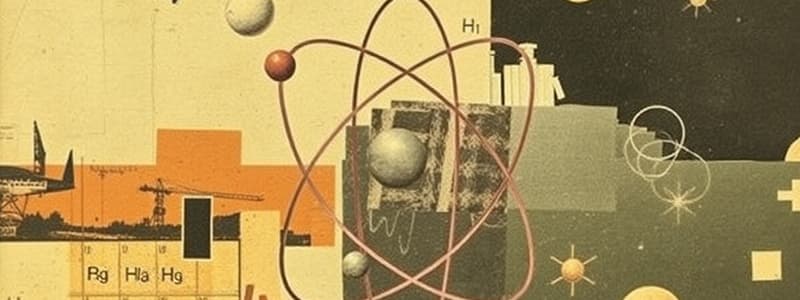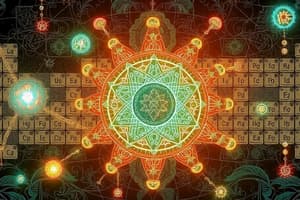Podcast
Questions and Answers
What defines an element in the periodic table?
What defines an element in the periodic table?
- The total number of particles in the nucleus
- The number of protons it contains (correct)
- The number of neutrons it contains
- The number of electrons it contains
What type of bond is formed when electrons are shared between atoms?
What type of bond is formed when electrons are shared between atoms?
- Metallic bond
- Hydrogen bond
- Covalent bond (correct)
- Ionic bond
Which state of matter has a definite shape and volume?
Which state of matter has a definite shape and volume?
- Liquid
- Gas
- Solid (correct)
- Plasma
In a chemical reaction, which substances are considered reactants?
In a chemical reaction, which substances are considered reactants?
What is the pH range for basic substances?
What is the pH range for basic substances?
Which type of reaction involves the exchange of ions between two compounds?
Which type of reaction involves the exchange of ions between two compounds?
What is the main characteristic of an exothermic reaction?
What is the main characteristic of an exothermic reaction?
Which particles are found in the nucleus of an atom?
Which particles are found in the nucleus of an atom?
Study Notes
Fundamental Concepts
- Atoms: The basic unit of matter, consisting of protons, neutrons, and electrons.
- Elements: Pure substances that cannot be broken down; defined by the number of protons (atomic number).
- Compounds: Substances formed from two or more elements chemically bonded together.
Atomic Structure
- Protons: Positively charged particles found in the nucleus.
- Neutrons: Neutral particles also located in the nucleus.
- Electrons: Negatively charged particles orbiting the nucleus in electron shells.
The Periodic Table
- Organized by increasing atomic number and grouped by similar chemical properties.
- Groups: Columns that share similar valence electron configurations.
- Periods: Rows representing elements with the same number of electron shells.
Chemical Bonds
- Ionic Bonds: Formed by the transfer of electrons from one atom to another, resulting in oppositely charged ions.
- Covalent Bonds: Occur when atoms share electrons.
- Metallic Bonds: Characterized by a sea of delocalized electrons around metal cations.
States of Matter
- Solid: Definite shape and volume; particles are tightly packed.
- Liquid: Definite volume but no definite shape; particles are close but can move past each other.
- Gas: No definite shape or volume; particles are far apart and move freely.
Chemical Reactions
- Reactants: Substances that undergo changes during a reaction.
- Products: New substances formed as a result of a chemical reaction.
- Types of Reactions:
- Synthesis: Two or more substances combine to form a new compound.
- Decomposition: A compound breaks down into simpler products.
- Single Displacement: One element replaces another in a compound.
- Double Displacement: Exchange of ions between two compounds.
Acids and Bases
- Acids: Substances that donate protons (H⁺) in a solution; have a pH less than 7.
- Bases: Substances that accept protons or donate hydroxide ions (OH⁻); have a pH greater than 7.
- pH Scale: Measures the acidity or basicity of a solution (0-14 scale).
Stoichiometry
- The calculation of reactants and products in chemical reactions.
- Based on the law of conservation of mass; matter is not created or destroyed.
Thermochemistry
- Study of energy changes during chemical reactions.
- Exothermic Reactions: Release energy (heat).
- Endothermic Reactions: Absorb energy (heat).
Organic Chemistry
- Study of carbon-containing compounds.
- Functional Groups: Specific groups of atoms that determine the properties of organic molecules (e.g., hydroxyl, carboxyl).
Biochemistry
- Study of chemical processes within living organisms.
- Focus on macromolecules: proteins, carbohydrates, lipids, and nucleic acids.
Chemical Safety
- Always wear appropriate personal protective equipment (PPE).
- Understand material safety data sheets (MSDS) for chemicals used.
Fundamental Concepts
- Atoms are the building blocks of matter comprising protons, neutrons, and electrons.
- Elements are pure substances that cannot be broken down and are determined by the number of protons, known as the atomic number.
- Compounds are substances formed when two or more elements chemically bond together.
Atomic Structure
- Protons, positively charged particles, reside in the nucleus.
- Neutrons, neutral particles, also reside in the nucleus.
- Electrons, negatively charged particles, orbit the nucleus in shells.
### The Periodic Table
- The periodic table is organized by increasing atomic number, with elements grouped based on similar chemical properties.
- Groups are columns representing elements with similar valence electron configurations.
- Periods are rows representing elements with the same number of electron shells.
Chemical Bonds
- Ionic Bonds form when electrons transfer from one atom to another, resulting in oppositely charged ions.
- Covalent Bonds occur when atoms share electrons.
- Metallic Bonds are characterized by a "sea" of delocalized electrons surrounding positively charged metal ions.
States of Matter
- Solids have a definite shape and volume with tightly packed particles.
- Liquids have a definite volume but no definite shape, with particles that are close but can move.
- Gases have no definite shape or volume, with particles that are far apart and move freely.
Chemical Reactions
- Reactants are substances that change during a reaction.
- Products are new substances formed as a result of a chemical reaction.
- Types of Reactions:
- Synthesis: Two or more substances combine to form a new compound.
- Decomposition: A compound breaks down into simpler products.
- Single Displacement: One element replaces another in a compound.
- Double Displacement: Exchange of ions between two compounds.
Acids and Bases
- Acids donate protons (H⁺) in solution, having a pH less than 7.
- Bases accept protons or donate hydroxide ions (OH⁻), having a pH greater than 7.
- The pH scale measures the acidity or basicity of a solution ranging from 0 (most acidic) to 14 (most basic).
Stoichiometry
- Stoichiometry calculates the quantities of reactants and products in chemical reactions.
- Based on the law of conservation of mass, matter is not created or destroyed in a chemical reaction.
Thermochemistry
- Thermochemistry is the study of energy changes during chemical reactions.
- Exothermic Reactions release energy, typically heat.
- Endothermic Reactions absorb energy, typically heat.
Organic Chemistry
- Organic chemistry focuses on carbon-containing compounds.
- Functional Groups, specific groups of atoms, determine the properties of organic molecules (e.g., hydroxyl, carboxyl).
Biochemistry
- Biochemistry studies chemical processes within living organisms.
- It focuses on macromolecules: proteins, carbohydrates, lipids, and nucleic acids.
Chemical Safety
- Always use appropriate personal protective equipment (PPE) when working with chemicals.
- Familiarize yourself with Material Safety Data Sheets (MSDS) for the chemicals you use.
Studying That Suits You
Use AI to generate personalized quizzes and flashcards to suit your learning preferences.
Description
This quiz covers the fundamental concepts of chemistry, including atoms, elements, and compounds. It also delves into atomic structure and the periodic table, explaining the organization of elements and the types of chemical bonds. Test your understanding of these essential topics in chemistry!




